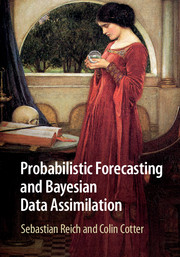A postscript
Published online by Cambridge University Press: 05 May 2015
Summary
We have come to the end of our introduction to ensemble-based forecasting and data assimilation algorithms. The field is rapidly developing and key challenges come from imperfect model scenarios and the high dimensionality of models. While certain particle filters are asymptotically optimal within a perfect model scenario, this picture is much less clear for “real world” data assimilation problems. Here the ensemble Kalman filter has been shown to be both robust and sufficiently accurate for many practical problems. However, it should be kept in mind that most successful applications of the ensemble Kalman filter have arisen against a background of relatively advanced mechanistic models and for problems for which the forecast uncertainties can be approximated by Gaussian distributions. Further challenges arise when, in the absence of accepted mechanistic design principles, only crude empirical models are available and model parameters as well as model states need to be estimated. Ideally, in such cases one might wish to convert empirical models into mechanistic design principles by extracting causalities from data using data assimilation algorithms. These topics are beyond our introductory textbook and we end by inviting the reader to become an active participant in the exciting enterprise called probabilistic forecasting and data assimilation.
- Type
- Chapter
- Information
- Publisher: Cambridge University PressPrint publication year: 2015

